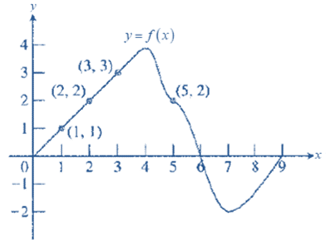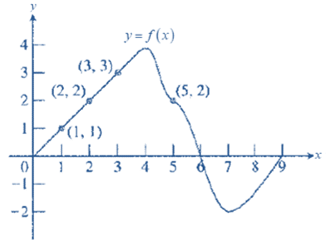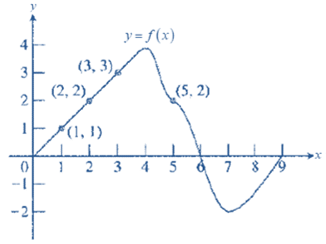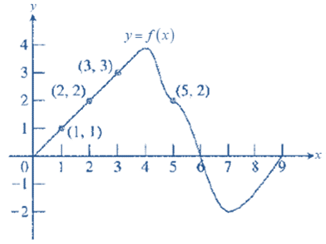
Concept explainers
(a)
Particle’s velocity at time
(a)
Answer to Problem 58E
The velocity at
Explanation of Solution
Given information:
Position at time t (sec) of a particle moving along a coordinate axis:
Where,
f is the differentiable function

The velocity of s is s’.
Since
Then
According to FTC (Fundamental Theorem of Calculus),
The velocity at
From the graph,
Thus,
The velocity at
(b)
Whether the acceleration of particle at time
(b)
Answer to Problem 58E
The acceleration of particle is negative at
Explanation of Solution
Given information:
Position at time t (sec) of a particle moving along a coordinate axis:
Where,
f is the differentiable function

The acceleration of s is s”.
Since
Then
According to FTC (Fundamental Theorem of Calculus),
Second derivative:
That means
From the graph,
The slope of f at 5 is negative.
Thus,
Therefore,
The acceleration of particle is negative at
(c)
Particle’s position at time
(c)
Answer to Problem 58E
Particle’s position at 3 seconds is 4.5.
Explanation of Solution
Given information:
Position at time t (sec) of a particle moving along a coordinate axis:
Where,
f is the differentiable function

The region between
Then
The position at 3 seconds:
Therefore,
Particle’s position at 3 seconds is 4.5.
(d)
Time during the first 9 sec for s have its largest value.
(d)
Answer to Problem 58E
The largest value for s occurs at
Explanation of Solution
Given information:
Position at time t (sec) of a particle moving along a coordinate axis:
Where,
f is the differentiable function

s will have the largest value when it reaches the absolute maximum.
In order to know where the maximum occurs,
We are required to find at what value of t the first derivative of s switches from being positive to negative.
Since
Then
According to FTC (Fundamental Theorem of Calculus),
From the graph,
f is positive for 0 to 6 and negative for 6 to 9.
Therefore,
For
s must be larger at
Since
Then
Since
Then
Thus,
s is larger at
Therefore,
The largest value for s occurs at
(e)
Approximate the zero value of acceleration.
(e)
Answer to Problem 58E
The acceleration is zero when
Explanation of Solution
Given information:
Position at time t (sec) of a particle moving along a coordinate axis:
Where,
f is the differentiable function

Since
At
We have
Also,
At
We have
Therefore,
Acceleration is zero at both 4 seconds and 7 seconds.
(f)
Movement of the particle towards and away from the origin.
(f)
Answer to Problem 58E
The particle moves away from the origin in the positive direction on the interval [0, 6].
The particle moves towards the origin in the negative direction on the interval [6, 9].
Explanation of Solution
Given information:
Position at time t (sec) of a particle moving along a coordinate axis:
Where,
f is the differentiable function

Note that
Such that
The particle is at origin at
On the interval [0, 6]:
We have
Thus,
The particle moves away from the origin in the positive direction.
On the interval [6, 9]:
We have
Also,
The area below the x-axis is smaller above the x-axis.
Thus,
The particle moves towards the origin in negative direction.
(g)
Side of the origin for the particle at time
(g)
Answer to Problem 58E
The particle lies on positive side of the origin at time
Explanation of Solution
Given information:
Position at time t (sec) of a particle moving along a coordinate axis:
Where,
f is the differentiable function

Since the particle starts at the origin,
Then
Also,
The area below the x-axis between
Thus,
Therefore,
The particle lies on the positive side of the origin at 9 seconds.
Chapter 6 Solutions
Calculus 2012 Student Edition (by Finney/Demana/Waits/Kennedy)
Additional Math Textbook Solutions
Precalculus (10th Edition)
University Calculus: Early Transcendentals (4th Edition)
Calculus, Single Variable: Early Transcendentals (3rd Edition)
Calculus & Its Applications (14th Edition)
University Calculus: Early Transcendentals (3rd Edition)
 Calculus: Early TranscendentalsCalculusISBN:9781285741550Author:James StewartPublisher:Cengage Learning
Calculus: Early TranscendentalsCalculusISBN:9781285741550Author:James StewartPublisher:Cengage Learning Thomas' Calculus (14th Edition)CalculusISBN:9780134438986Author:Joel R. Hass, Christopher E. Heil, Maurice D. WeirPublisher:PEARSON
Thomas' Calculus (14th Edition)CalculusISBN:9780134438986Author:Joel R. Hass, Christopher E. Heil, Maurice D. WeirPublisher:PEARSON Calculus: Early Transcendentals (3rd Edition)CalculusISBN:9780134763644Author:William L. Briggs, Lyle Cochran, Bernard Gillett, Eric SchulzPublisher:PEARSON
Calculus: Early Transcendentals (3rd Edition)CalculusISBN:9780134763644Author:William L. Briggs, Lyle Cochran, Bernard Gillett, Eric SchulzPublisher:PEARSON Calculus: Early TranscendentalsCalculusISBN:9781319050740Author:Jon Rogawski, Colin Adams, Robert FranzosaPublisher:W. H. Freeman
Calculus: Early TranscendentalsCalculusISBN:9781319050740Author:Jon Rogawski, Colin Adams, Robert FranzosaPublisher:W. H. Freeman
 Calculus: Early Transcendental FunctionsCalculusISBN:9781337552516Author:Ron Larson, Bruce H. EdwardsPublisher:Cengage Learning
Calculus: Early Transcendental FunctionsCalculusISBN:9781337552516Author:Ron Larson, Bruce H. EdwardsPublisher:Cengage Learning





